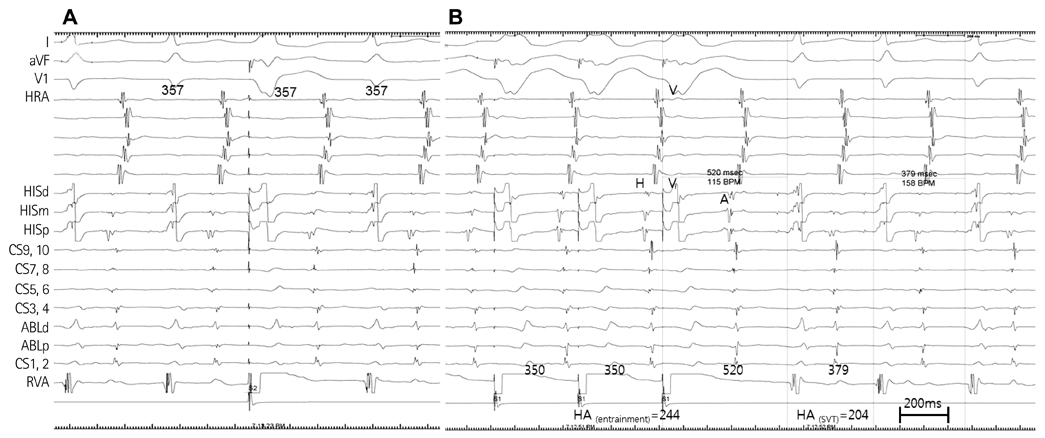Korean Circ J.
2013 Mar;43(3):189-192. 10.4070/kcj.2013.43.3.189.
Successful Ablation of Resistant Left Lateral Accessory Pathway and Coexisting Atypical Atrioventricular Nodal Reentrant Tachycardia
- Affiliations
-
- 1Division of Cardiology, Department of Internal Medicine, Inje University College of Medicine, Ilsan Paik Hospital, Goyang, Korea. jnamgung@paik.ac.kr
- KMID: 2224964
- DOI: http://doi.org/10.4070/kcj.2013.43.3.189
Abstract
- A 41-year-old male was presented with drug-resistant supraventricular tachycardia. Electrophysiological study confirmed that the supraventricular tachycardia was caused by dual atrioventricular nodal pathways and a left lateral accessory pathway (AP). The left lateral AP was resistant to traditional endocardial ablation, but was successfully eliminated by radiofrequency ablation via the intracoronary sinus approach.
Keyword
MeSH Terms
Figure
Reference
-
1. Chen YJ, Chen SA, Chiang CE, et al. Dual AV node pathway physiology in patients with Wolff-Parkinson-White syndrome. Int J Cardiol. 1996. 56:275–281.2. Becker AE, Anderson RH, Durrer D, Wellens HJ. The anatomical substrates of wolff-parkinson-white syndrome. A clinicopathologic correlation in seven patients. Circulation. 1978. 57:870–879.3. Jackman WM, Wang XZ, Friday KJ, et al. Catheter ablation of accessory atrioventricular pathways (Wolff-Parkinson-White syndrome) by radiofrequency current. N Engl J Med. 1991. 324:1605–1611.4. Calkins H, Langberg J, Sousa J, et al. Radiofrequency catheter ablation of accessory atrioventricular connections in 250 patients. Abbreviated therapeutic approach to Wolff-Parkinson-White syndrome. Circulation. 1992. 85:1337–1346.5. Lesh MD, Van Hare GF, Schamp DJ, et al. Curative percutaneous catheter ablation using radiofrequency energy for accessory pathways in all locations: results in 100 consecutive patients. J Am Coll Cardiol. 1992. 19:1303–1309.6. Haissaguerre M, Gaita F, Fischer B, Egloff P, Lemetayer P, Warin JF. Radiofrequency catheter ablation of left lateral accessory pathways via the coronary sinus. Circulation. 1992. 86:1464–1468.
- Full Text Links
- Actions
-
Cited
- CITED
-
- Close
- Share
- Similar articles
-
- A case of AV reentrant tachycardia utilizing a left lateral accessory pathway with long VA conduction time
- Atrioventricular Nodal Reentrant Tachycardia (AVNRT)
- Radiofrequency Catheter Ablation of Atrioventricular Nodal Reentrant Tachycardia in Two Patients with Persistent Left Superior Vena Cava
- Clinical Experiences in Radiofrequency Catheter Ablation
- Familial Occurrence of Atrioventricular Nodal Reentrant Tachycardia in a Mother and Her Son





